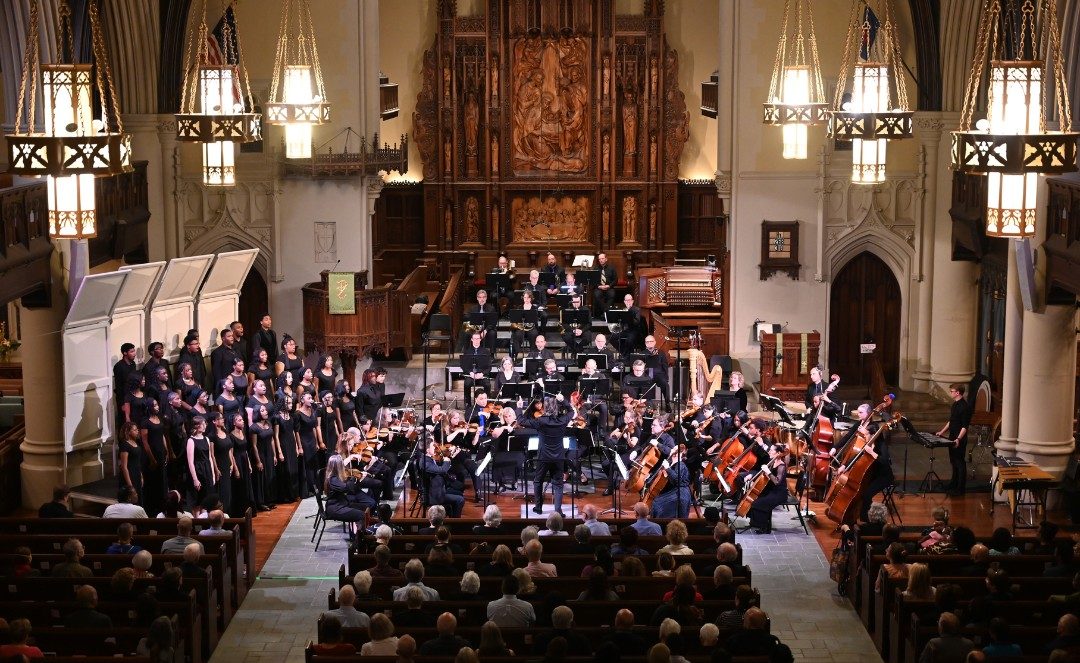by Kevin McLaughlin

As a glorious opener, the Cleveland School of the Arts R. Nathaniel Dett Concert Choir (Robert McCorvey, director) and the BlueWater Orchestra combined forces during four spiritual and gospel arrangements. CSA also supplied select string players from the school to sit alongside the professionals, adding tonal depth and youthful energy.
André Thomas’s I Dream a World, dedicated to the victims of the September 11, 2001 terrorist attacks, was made more poignant by the poetry of Langston Hughes: “I dream a world where man / No other man will scorn, / Where love will bless the earth / And peace its paths adorn…”
Adolphus Hailstork’s “He’s Got the Whole World in His Hands,” the final movement of a set of spirituals, was made even sweeter by the two soprano soloists.
Freedom’s Plow, composed by Case Western’s own Rollo Dilworth, is a dramatic call to unity combining excerpts from Langston Hughes’ poem of the same name and the spiritual “Hold On.” Buoyed by an animated orchestra, the choir sang out a timely message: “That tree is for everybody, / For all America, for all the world / May its branches spread and shelter grow / Until all races and all peoples know its shade. / Keep your hand on the plow! Hold on!”
Newly-commissioned trumpet concertos seldom come along these days, but even rarer is a trumpet-forward work that addresses such heady subjects as life’s ephemerality and the linearity of time, like David Biedenbender’s River of Time. “I imagine crossing time, bending time, moving backward and forward through it,” the composer has said of the work.
Biedenbender has written a concerto for trumpet and orchestra that manages to state both universal and intimate themes, but what lingers in the mind is how engrossing and hugely communicative the music is.
In comments made beforehand, Biedenbender recounted the genesis of the piece and his collaboration with soloist Neil Mueller, a former colleague at Central Michigan University. A casual phrase from a conducting mentor (“Time flows like a river”) gave Biedenbender the title and a plan, and his friendship with Mueller helped guide its creation.
Mueller’s trumpet tone also seemed to shape the essence of the piece. He plays with an uncommon warmth, encircling notes with a soulful nimbus of sound. The ringing sound of solo trumpet, especially one as radiant as Mueller’s, also has a way of making the memory of such music more vivid and lasting. Trumpet is a compelling messenger.
River of Time’s fleeting nature, in three continuous movements, is not just an implicit expression of the composer’s skill and efficiency, it also serves to illustrate the work’s thesis: that time is a gift and is quickly passing.
The composer’s description of the first movement (“Becoming”) as a “primordial clock” is mimicked by the “ticking” sounds of pizzicato strings, harp, and xylophone, as the trumpet asks tentative “unanswerable questions” (à la Charles Ives?). The trumpet enters with short, doleful phrases sometimes bending downward — setting a mood but also recalling Salvador Dalí’s melting clocks — while meters shift and harmonies intensify. Meyer kept a firm grasp on all of this, both propelling and following the flow. At an emotional high point, there comes a pause and a new movement begins. Has it been three days, or just a few minutes?
The middle movement, “Flowing,” also considers time, but zooming in from the cosmic to the human level. The music becomes dreamy: our hearts slow, the river eddies, and we contemplate. As the composer invited us to during his pre-concert interview, we recalled a memorable moment in our lives, a quiet time spent with loved ones. Mueller brought unmitigated loveliness here, with long arching lines soaring to the highest reaches of the instrument. I felt a general relaxation and serenity, pondering what moments in life matter most.
The finale, “Crossing,” a restless, agitated rhapsody, also left lingering questions. Is time linear or can it be bent? What if we could exist outside of time? What if we could traverse the river of time? Virtuosic writing is added to the soloist’s load — fast spider-like runs, triple tonguing passages, rhythmic complexity, and a nice high C as a final exclamation point.
A standing ovation ensued, as soloist, composer, and orchestra all savored this moment in time.
Although the sense of occasion and success of Biedenbender’s work may have created a sense of climax, Daniel Meyer and the ensemble only seemed exhilarated, turning their energies next to Beethoven’s Fifth.
The pared-back texture of the chamber orchestra highlighted melodic lines and harmonies, and Meyer guided a performance of ample power made even more so by careful management of clarity and balance. I am not a fan of this beautiful church’s acoustics for orchestra concerts, but important elements came intrepidly across: contrasting dynamics, elegant phrasing and articulation all added up to secure ensemble playing.
The first chair standouts were flutist Sean Gabriel, piccolo player Kyra Kester, oboist Martin Neubert, and horn player Ken Wadenpfuhl — and all three trombones, whose heroic playing turned the excitement up to eleven. It was a remarkable performance by BlueWater, doing justice to the most famous four notes in music, and to the hundreds of others that followed.
Published on ClevelandClassical.com October 15, 2024
Click here for a printable copy of this article



